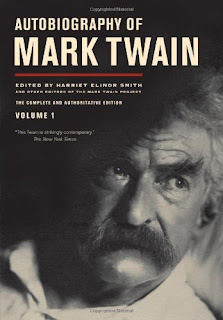For
almost 40 years, Mark Twain had worked fitfully on his autobiography. A story
here, a remembrance there, a chapter or two in between – but the project seemed
to be shelved over and over again, the pieces he completed likely incorporated
into articles, speeches, stories and books. Then, in 1905, he decided to
dictate the story of his life, hiring a secretary for the specific work. Almost
four years and 500,000 words later, he was done.
And
then he decided that it wouldn’t be published for 100 years after his death.
Two years after Twain’s death in 1910, some 90,000
words of the autobiography were published by his own literary executor, Albert Bigelow Paine
(1861-1937). Then historian Bernard Devoto (1897-1955)
followed suit in the 1940s. In the late 1950s, historian Charles Neider (1915-2001)
similarly used
large parts of the autobiography manuscript. Paine and Devote stayed true
to the way Twain had dictated the manuscript – more reminiscences than orderly
chronology – while Neider restructured what he used into a more standard
chronological account.
In
2010 (the 100th anniversary of Twain’s death), the Mark Twain Project, part of the
Mark Twain Papers at the University of California, published the first of three
volumes constituting not only Twain’s autobiography but associated papers and
articles as well as extensive scholarly notes. The publication was edited by
Harriet Elinor Smith, one of the Mark Twain Project editors.
The
official title of the first volume is The
Autobiography of Mark Twain: The Complete and Authoritative Edition, Vol. 1.
It represents an astonishing amount of work.
The
portion of volume 1 that is Twain’s autobiography proper occupies about 270
pages. It’s preceded by 200 pages of introduction and related articles and
writings by Twain (the introduction alone is almost 60 pages, and well worth
reading to understand both how Twain write his autobiography and how Paine,
Devoto and Neider did and didn’t follow his instructions). This first portion of
autobiography is followed by 210 pages of explanatory notes, 30 pages of references,
and a 23-page index. This, obviously, is a huge scholarly undertaking.
Parts
of the autobiography are more than familiar – 30 years ago, I had read a
three-volume reprint of Paine’s The
Autobiography of Mark Twain that I had found on a remaindered table at a
local bookstore. This was a 1980 reprint of the original 1912 edition.
Both
the Paine edition and the new University of California Press edition are
vintage Twain. He apparently found himself unable to produce a standard,
chronological account (likely one result of dictating the work). He says as
much as he explains his plan: “…start it at no particular time of your life;
wander at your free will all over your life; talk only about the thing which
interests you for the moment; drop it the moment its interest threatens to
pale; and turn your talk upon the new and more interesting thing that has
intruded itself into your mind meantime.”
Notice
that he refers to the work as a talk. The autobiography more resembles a
folksy, sitting-around-the-cracker-barrel speech than it does a literary
endeavor. There’s no question that Twain took himself and his writings
seriously; but he gives the perception of casualness, down-home, speech of the
people, almost as if this is an effortless undertaking.
And
it’s funny, filled with the trademark brand of humor than made (and still
makes) Twain famous, as in “Recently some one in Missouri has sent me a picture
of the house I was born in. Heretofore I have always stated that it was a palace,
but I shall be more guarded, now.” He was actually born in the town of Florida,
Missouri, but grew up in Hannibal, some 35 miles away. Hannibal has a tourist
economy built around Mark Twain.
Included
in this first volume are (in no particular order) stories about his birth and
growing up; working as an editor in the Nevada territory; his family’s fixation
on the “land back in Tennessee’ that was to be their financial windfall; and stories
about Horace Greeley, William Dean Howells, George Washington Cable, John Hay,
John Greenleaf Whittier, Helen Keller, and Nikolai Tchaikovsky, among others
(he met these people at different times of his life). And the volume also has
his moving account of the death of his brother Henry in 1858 from injuries
received during an explosion of the steamboat Pennsylvania on the Mississippi River.
This
is a wonderful effort the Mark Twain Project has undertaken, to publish this
autobiography as well as Twain’s other works. He remains one of the greatest
American writers; he is certainly the quintessential American writer.
Top photograph: Mark Twain’s boyhood
home in Hannibal, Missouri, by Andrew Balet via Wikimedia
Commons.



1 comment:
nice white fence at the old palace. :-)
Post a Comment